Embryos, “croquodinosaurs” and killer meteorite
But one thing is to advance in science and another thing is to do it in the style of Hollywood (rich in sex and violence). But leaving aside sensationalism, it would be better to explain what has been advanced and what has not.
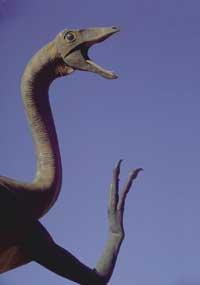
The discoveries have been made in the rocks of the Cretaceous, the first in Nigeria, the second in South America and the third in the Pacific. There are threads between the three, which are from the same geological epoch, but I think only there comes the link. However, others, for example, journalists, want to bring more link, than as published in various media, "In the end the meteorite that killed the dinosaurs has been found" and "The aggressor has been identified.
Theropod dinosaurs are known to be stars of various movies. Who does not know Tyranosaurus rex or Velociraptor, wild and terrifying carnivores? In addition, for many dinosaurs, a branch of these theropods developed current birds. But, in addition to this, within the group of theropods emerged several subgroups of striking aspect, until that of the theropods became one of the groups of greatest evolutionary success of all time.
One of the subgroups developed within the theropods was spinosaurs. Based on the material found in an Egyptian oasis, paleontologist Ernst first described spinosaurs in the first part of this century. Fosilo took them to Munich, but they were lost during World War II in the bombing that destroyed the city. Until then, spinosaurs were "destroyed twice": for the first time in the late Cretaceous, 95 million years ago, and for the second time 53 years ago. The only material that was saved was that published in the scientific literature before the war.
But, as I will explain later, spinosaurs were very spectacular dinosaurs and several paleontologists began to look for more fossils of this group. The search has been complex and laborious, but gradually these works have borne fruit. Consequently, in England, Brazil and Africa some loose fossils of these dinosaurs have appeared in recent years. The last one was made by Paul Sereno and his companions from Niger, and unlike those mentioned in the previous line, this time has appeared almost the entire skeleton, in addition to a new genus and species, the Suchomimus tenerensis.
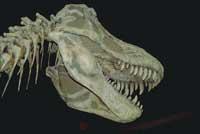
Its name explains its shape and origin, Suchomimus, imitator of crocodiles, and tenerensis Tenere of the desert. This suchomimus, although very special in appearance, had common characteristics with the spinosaurs found above. Suchomimus, about twelve meters in total length, moved mostly on the two hind legs, with the front hands and long sickle-shaped claws, the longest 33 centimeters, with a wide sail on the back and long and conical tips like crocodiles. Moreover, this peculiar anatomy of the head and the fossils of the fish found inside indicate that he ate fish. As a test the fossil of a three-metre celacanthus has been found inside a spinosaur.
But in addition to fish, the skeleton of a young Iguanodon dinosaur has been found inside a spinosaur. Therefore, these dinosaurs had both fish and terrestrial animals in their diet. However, this Suchomimus did not spend much time in the water, as he had only prepared the end to fish. The African rivers of that time were full of large crocodiles. Probably the Suchomimus would only enter the water to fishing. Fisherman yes, but no swimmer!
Suchomimus is more like other European spinosaurs than Africa or Brazil. At that time, on Earth there were only two main continents, north of Laurasia and south of Gondwana, half divided. Between these two continents was the sea of Tetis.
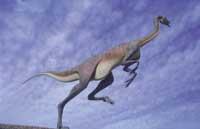
But it seems that Suchomimus evolved from the Europeans, that is, from those of Laurasia. This means that spinosaurs, in one way or another, were able to cross the sea of Tetis.
This has been proposed for other groups of beings, although the mechanism is not very clear. To me, however, it occurs to me that the sporadic bridge between Laurasia and Gondwana could be a long and narrow continent, now disappeared. Cimacio, a few years ago, has been buried in the Alpe and Himalaia mountains. It seems that moving Africa north collided with Europe catching Zimeria between the two. The charrería folded, wrinkled and became part of Europe.
However, the rocks of Zimeria are very modified and have lost most of their fossils. That is why it is difficult to know if this continent, narrow and long, was a true bridge between Laurasia and Gondwana. Time and more research will answer us. As mentioned above, spinosaurs, for unknown reasons, were destroyed at the beginning of the Late Cretaceous, while many other dinosaurs continued their course. Some of the surviving dinosaurs lived in Argentina and probably laid eggs, like many current penguins and other birds, in a common place. About 80 million years ago a large flood flooded thousands of eggs from a group of dinosaurs in a place today north of Patagonia.
These eggs were fossilized under the sludge brought by water and a few months ago paleontologists have renewed idoles3. The eggs are spherical, 15 centimeters in diameter and with warts on the outside. Fossil eggs of this type have been found in other parts of the world, but they have always been empty and the type of dinosaurs they put has not been known. About 50 of the Argentines have fossilized embryos inside them.
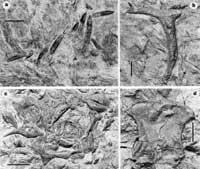
In view of the anatomy of the embryos, it has been discovered that the eggs were burned by the sauropod dinosaurs, the titanosaurs. Moreover, fossil eggs of sauropod dinosaurs have been found in China and North America, Laurasia, but not in Gondwana. Argentines are the first in Gondwana.
The Argentine embryos were quite developed, almost willing to be born, and the skin had a decorative organization with scales. The embryos of a few other dinosaurs found previously in other parts of the world contained only bones, while in Argentina for the first time the skin of the embryos of some dinosaurs has been fossilized. But not only have skin and bones appeared, but also teeth. These embryos, as already indicated, belonged to some sauropod dinosaurs that were herbivores. Sauropods, like current herbivores, were eroded over time by the crowns of the teeth and were very smooth. For the teeth of the Argentine embryos suffer erosion in the crowns. This shows that within the egg embryos rubbed the teeth of the lower and upper jaws together. This friction seems to show that the embryos before birth exercised to strengthen the muscles of the cheeks.
Although some 80 million years ago in Argentina a flood destroyed the thousands of eggs of a group of dinosaurs, the dinosaurs were not destroyed at all and survived in another 15 million years. These animals were not destroyed, but were reduced at the end of the Cretaceous. Finally, 65 million years ago dinosaurs and many other creatures, both terrestrial and aquatic, became extinct. In those that were not destroyed there are reptiles such as crocodiles and turtles, such as birds and mammals. Perhaps the dinosaurs had continuity in the birds.
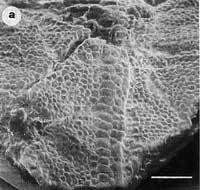
But what caused that mass destruction? This question was launched in the 19th century and for decades paleontologists have tried to answer.
About 30 years ago, California geologist Walter Alvarez began to investigate the end of the Cretaceous in Italy. By then geologists already knew a thin layer of clay over the final rocks of the Cretaceous. This layer of clays appears in many places in the world, including many places in the Basque Country, and is very useful for easily detecting the end of the Cretaceous. Walter Alvarez wanted to calculate the time it would take to form this layer of unknown origin and for this he turned to his father Luis, Nobel Prize in Physics. A method was proposed between the two: measuring the concentration of iridium clay. Iridium is very scarce in the surface rocks of the Earth, but abundant in meteorites. Meteorites, especially those of small size (that is, around the millimeter), do not stop entering and falling into our atmosphere. Consequently, the iridium caused by meteorites is accumulating at constant speed in the sediments.
Walter and Luis, knowing the speed of iridium accumulation, thought that it would be possible to measure the time needed to form a rock body, since the concentration and time in the iridium rock are united by a simple mathematical formula. Since it was technically very difficult (since there are only nanograms of iridium), with the help of physicist Frank Asaro, the concentration of iridium was measured and the formation time of the final clay of the Cretaceous was calculated. Surprisingly, the final clay of the Cretaceous, unlike the lower and upper rocks, was very rich in iridium.
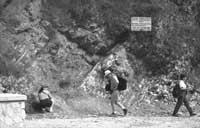
Did that mean that the clay accumulated for a long time? Maybe for millions of years? The fossils of the rocks below and above the clay said no, that the clay accumulated in a short time! But how to explain the great concentration of iridium?
The only explanation they came up with was the impact of the giant meteorite. As mentioned above, meteorites are rich in iridium and thought that the great concentration of iridium was explained by the fall of a large meteorite. They say that a meteorite of at least 10 kilometers collided with the Earth at the end of the Cretaceous and enriched with iridium the sediments of the world. Being a giant collision (at least 50 million times greater than that of the Hiroshima bomb), it could cause drastic changes such as one-kilometer-high tsunamis, very violent earthquakes, continental fires, nuclear winter, darkness of months, depth, acidification of the greenhouse effect of the seas, etc.
This would cause many creatures to die. For Alvarez, father and son, and Asaro, this would explain the extinctions of the Cretaceous. There was no other explanation. In addition, Father Alvarez was the scientific monitor who was traveling on the plane that launched the bomb in Hiroshima (according to some sources, which activated the spouser of the bomb before launch) and was very clear how this event could be.
But where was the crater that would form this clash? Crater Luis Álvarez died without knowing where he could be. Years later a crater of more than a hundred kilometers was discovered at the end of the Cretaceous, the Chicxulub crater, buried under the Yukatan peninsula. The crater did, but where was the meteorite that formed the crater?
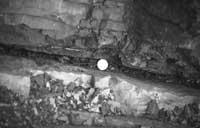
Was the meteorite an asteroid or comet? In recent years there have been arguments both that, according to some, would show that the striking was the comet. This small meteorite is relatively chemically altered, but its mineralogical composition shows that it was a carbon condrite. The discovery was made 9,000 kilometers from Chicxulub and, according to the author of the work, shows that at the end of the Cretaceous it was hit by an asteroid marine platform, not by a comet, around the current peninsula of Yukatan.
However, as I have written before, meteorites continually fall to Earth. The smaller, the more frequent. It is possible, therefore, that at the end of the Cretaceous other smaller meteorites fall, apart from the fall in Yukatan, and therefore that the discovered is not part of the big. On the other hand, the final clay of the Cretaceous does not form a thin layer in the place of discovery. The sediments and iridium were mixed in a layer of 30 centimeters, not in a thin layer. It is estimated that these 30 centimeters can be 500,000 years, so the meteorite discovered and that of Yukattan may not be contemporary.
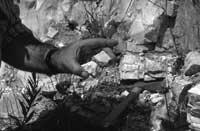
The Pacific meteorite, with or without part of the meteorite that formed the Chicxulub crater, does not show that the meteorite destroyed dinosaurs and other beings. Most scientists recognize that at the end of the Cretaceous one or more giant meteorites collided with Earth. But it is one thing that shock and destruction is a consequence of shock. In short, by the end of the Cretaceous several groups of beings descended on slope. Perhaps the impact of the meteorite was the last drop that overflowed the vessel. Moreover, we know the craters of many other major shocks, but in most cases they are not associated with destructions. Probably the cause of the destruction were several and to know them, the research of geologists still have a long way to go.
Buletina
Bidali zure helbide elektronikoa eta jaso asteroko buletina zure sarrera-ontzian











